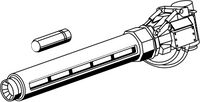Autocannon
Description
An Autocannon is a type of rapid-firing, auto-loading direct-fire ballistic weapon, firing high-explosive, armor-defeating rounds at targets in bursts. It is, basically, a giant "machine gun" that fires predominantly cased explosive shells, though models firing saboted high velocity kinetic energy penetrators, and caseless ordnance, do exist. Among the earliest tank/BattleMech scale weaponry produced, autocannons produce far less heat than energy weapons, but are considerably bulkier and are dependent upon limited stores of ammunition.
Autocannons range in caliber from 30mm up to 203mm and are loosely grouped according to their damage versus armor. The exact same caliber of shell fired in a 100 shot burst to do 20 damage will have a shorter effective range than when fired in a 10 shot burst to do 2 damage due to recoil and other factors. Autocannon are grouped into the following loose damage classes:[1]
Beyond the "standard" models, variants include the shotgun-like LBX, quick-firing Ultra and the gatling-type Rotary. Light-weight variants and capital ship scale models also exist. The experimental Hypervelocity Autocannon has also entered limited production.[2][3]
Early prototype autocannons were made as a progression forward from the rifle found on early tanks of Terra. The first AC/5 system was prototyped in 2240, The AC/2 came along later, with the first prototype debuting in 2290, and the and the first AC/10 system was formally made over two hundred years later in 2443 (though, technically it was made earlier for the Mackie, the AC/10 was formally prototyped in 2443). The AC/20 was first developed in 2490.[4] These prototypes functioned largely similar to modern autocannons, but they had rare tendencies to jam, locking up the weapon for the duration of the rest of the battle.[5] They can only carry three quarters of the ammunition per ton compared to modern autocannons as well.[5]
Standard autocannons can be tweaked by a technician (and game master/player approval) to double their rate of fire, similar to an Ultra Autocannon, however this carries some significant risk. Forcing an autocannon to fire at double its normal firing rate can jam the weapon. In the worst case, this can cause a detonation of the ammo in the cannon itself, destroying the gun, as well as likely damaging the internal structure of the mount location.[6]
An autocannon using the double fire rate functionality can use Walking Fire rule, normally locked to Ultra and Rotary autocannons.[7]
Caliber
Caliber is fluff for the size of the barrel that the shell or shells are fired from and no standard caliber has been set for any of the classes of Autocannon. Autocannon in a class vary by manufacturer and model. With the fluffed number of shells and caliber being specified, no Autocannon has been specified to be one shell fired for each "round" or burst of fire. One possible exception is the 210mm Ultra Autocannon/20 sometimes found on the Gargoyle C and Cauldron Born A OmniMechs. Other possible exceptions would be the Defiance Killer AC/10 mounted in the Hatchetman, as can be inferred from this text: "The Hatchetman carries 20 rounds in two ten-shot clips, much like the Federated Suns´ Enforcer, which lends credence to the rumors about Dr. Banzai." And by inference the Federated Autocannon/10 on the Enforcer.
Barrel Arrangement
All Rotary Autocannon are multiple-barrel arrangements.[1] Some standard, Light, and Ultra autocannons also use a multiple-barrel arrangement, but not as frequently.
References
- ↑ 1.0 1.1 TechManual, p. 207, "Autocannon"
- ↑ Tactical Operations, p. 285, "Autocannons"
- ↑ Experimental Technical Readout: Mercs, p. 8, "Warrior HX-9"
- ↑ Interstellar Operations, p. 118, "Prototype Dates For Basic Weapons Table"
- ↑ 5.0 5.1 Interstellar Operations, p. 118, "Primitive Prototype Equipment Rules"
- ↑ Tactical Operations p. 100 "Autocannons"
- ↑ Tactical Operations p. 100 "Autocannons"



